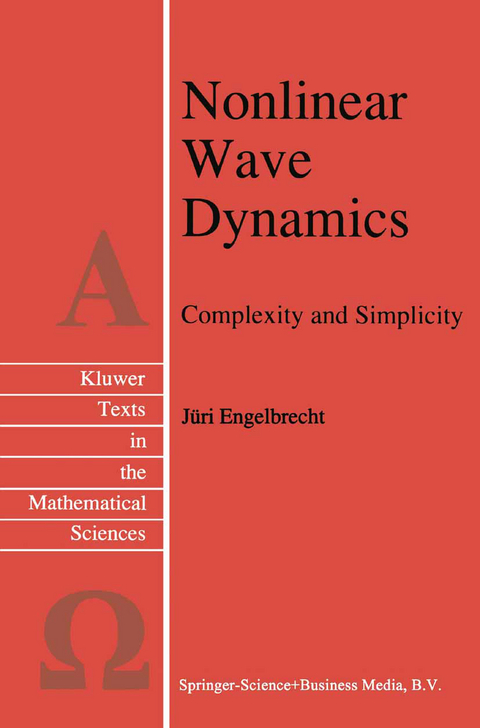
Nonlinear Wave Dynamics
Complexity and Simplicity
Seiten
1997
Springer (Verlag)
978-0-7923-4508-4 (ISBN)
Springer (Verlag)
978-0-7923-4508-4 (ISBN)
At the end of the twentieth century, nonlinear dynamics turned out to be one of the most challenging and stimulating ideas. The recent success of nonlinear dynamics is heavily biased towards temporal characterization widely using nonlinear ordinary differential equations.
At the end of the twentieth century, nonlinear dynamics turned out to be one of the most challenging and stimulating ideas. Notions like bifurcations, attractors, chaos, fractals, etc. have proved to be useful in explaining the world around us, be it natural or artificial. However, much of our everyday understanding is still based on linearity, i. e. on the additivity and the proportionality. The larger the excitation, the larger the response-this seems to be carved in a stone tablet. The real world is not always reacting this way and the additivity is simply lost. The most convenient way to describe such a phenomenon is to use a mathematical term-nonlinearity. The importance of this notion, i. e. the importance of being nonlinear is nowadays more and more accepted not only by the scientific community but also globally. The recent success of nonlinear dynamics is heavily biased towards temporal characterization widely using nonlinear ordinary differential equations. Nonlinear spatio-temporal processes, i. e. nonlinear waves are seemingly much more complicated because they are described by nonlinear partial differential equations. The richness of the world may lead in this case to coherent structures like solitons, kinks, breathers, etc. which have been studied in detail. Their chaotic counterparts, however, are not so explicitly analysed yet. The wavebearing physical systems cover a wide range of phenomena involving physics, solid mechanics, hydrodynamics, biological structures, chemistry, etc.
At the end of the twentieth century, nonlinear dynamics turned out to be one of the most challenging and stimulating ideas. Notions like bifurcations, attractors, chaos, fractals, etc. have proved to be useful in explaining the world around us, be it natural or artificial. However, much of our everyday understanding is still based on linearity, i. e. on the additivity and the proportionality. The larger the excitation, the larger the response-this seems to be carved in a stone tablet. The real world is not always reacting this way and the additivity is simply lost. The most convenient way to describe such a phenomenon is to use a mathematical term-nonlinearity. The importance of this notion, i. e. the importance of being nonlinear is nowadays more and more accepted not only by the scientific community but also globally. The recent success of nonlinear dynamics is heavily biased towards temporal characterization widely using nonlinear ordinary differential equations. Nonlinear spatio-temporal processes, i. e. nonlinear waves are seemingly much more complicated because they are described by nonlinear partial differential equations. The richness of the world may lead in this case to coherent structures like solitons, kinks, breathers, etc. which have been studied in detail. Their chaotic counterparts, however, are not so explicitly analysed yet. The wavebearing physical systems cover a wide range of phenomena involving physics, solid mechanics, hydrodynamics, biological structures, chemistry, etc.
1 Introduction: basic wave theory.- 2 Essential continuum mechanics.- 3 Nonlinearities: cornerstones for complexity.- 4 Nonlinear wave dynamics: mathematical models.- 5 Wave phenomena: complexities in modelling.- 6 Selected case studies.- 7 Essays: what is all that about.- 8 Final remarks: complexity of wave motion.- References.
| Erscheint lt. Verlag | 31.5.1997 |
|---|---|
| Reihe/Serie | Texts in the Mathematical Sciences ; 17 |
| Zusatzinfo | XIV, 185 p. |
| Verlagsort | Dordrecht |
| Sprache | englisch |
| Maße | 156 x 234 mm |
| Themenwelt | Mathematik / Informatik ► Mathematik ► Analysis |
| Mathematik / Informatik ► Mathematik ► Angewandte Mathematik | |
| Naturwissenschaften ► Physik / Astronomie ► Mechanik | |
| Technik ► Maschinenbau | |
| ISBN-10 | 0-7923-4508-8 / 0792345088 |
| ISBN-13 | 978-0-7923-4508-4 / 9780792345084 |
| Zustand | Neuware |
| Haben Sie eine Frage zum Produkt? |
Mehr entdecken
aus dem Bereich
aus dem Bereich
Buch | Softcover (2024)
De Gruyter Oldenbourg (Verlag)
CHF 83,90
Buch | Softcover (2024)
De Gruyter Oldenbourg (Verlag)
CHF 83,90


